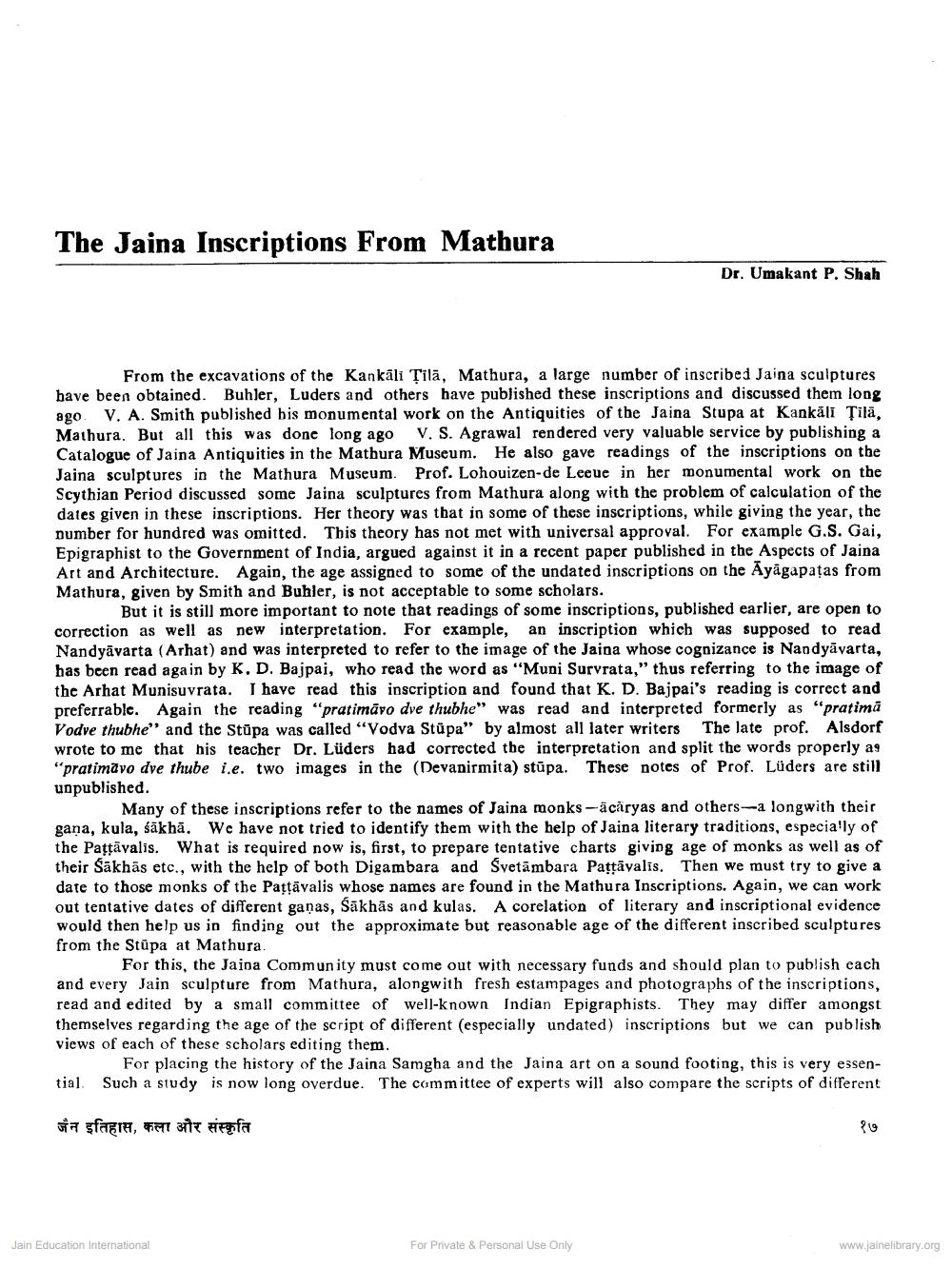________________
The Jaina Inscriptions From Mathura
Dr. Umakant P. Shah
From the excavations of the Kankāli Tila, Mathura, a large number of inscribed Jaina sculptures have been obtained. Buhler, Luders and others have published these inscriptions and discussed them long ago V. A. Smith published bis monumental work on the Antiquities of the Jaina Stupa at Kankāli Țila, Mathura. But all this was done long ago V. S. Agrawal rendered very valuable service by publishing a Catalogue of Jaina Antiquities in the Mathura Museum. He also gave readings of the inscriptions on the Jaina sculptures in the Mathura Museum. Prof. Lohouizen-de Leeue in her monumental work on the Scythian Period discussed some Jaina sculptures from Mathura along with the problem of calculation of the dates given in these inscriptions. Her theory was that in some of these inscriptions, while giving the year, the number for hundred was omitted. This theory has not met with universal approval. For example G.S. Gai, Epigraphist to the Government of India, argued against it in a recent paper published in the Aspects of Jaina Art and Architecture. Again, the age assigned to some of the undated inscriptions on the Ayagapatas from Mathura, given by Smith and Buhler, is not acceptable to some scholars.
But it is still more important to note that readings of some inscriptions, published earlier, are open to correction as well as new interpretation. For example, an inscription which was supposed to read Nandyāvarta (Arhat) and was interpreted to refer to the image of the Jaina whose cognizance is Nandyāvarta, has been read again by K. D. Bajpai, who read the word as "Muni Survrata," thus referring to the image of the Arhat Munisuvrata. I have read this inscription and found that K. D. Bajpai's reading is correct and preferrable. Again the reading "pratimāro dve thubhe" was read and interpreted formerly as "pratima Vodve thubhe" and the Stüpa was called “Vodva Stupa" by almost all later writers The late prof. Alsdorf wrote to me that his teacher Dr. Lüders had corrected the interpretation and split the words properly as "pratimăvo dve thube i.e. two images in the (Devanirmita) stūpa. These notes of Prof. Lüders are still unpublished.
Many of these inscriptions refer to the names of Jaina monks-acaryas and others-a longwith their gana, kula, sakha. We have not tried to identify them with the help of Jaina literary traditions, especially of the Pațţāvalis. What is required now is, first, to prepare tentative charts giving age of monks as well as of their Sākhās etc., with the help of both Digambara and Śyetambara Pattāyalis. Then we must try to give a date to those monks of the Pattāvalis whose names are found in the Mathura Inscriptions. Again, we can work out tentative dates of different ganas, Sakhās and kulas. A corelation of literary and inscriptional evidence would then help us in finding out the approximate but reasonable age of the different inscribed sculptures from the Stūpa at Mathura
For this, the Jaina Community must come out with necessary funds and should plan to publish cach and every Jain sculpture from Mathura, alongwith fresh estampages and photographs of the inscriptions, read and edited by a small committee of well-known Indian Epigraphists. They may differ amongst themselves regarding the age of the script of different (especially undated) inscriptions but we can publish views of each of these scholars editing them.
For placing the history of the Jaina Samgha and the Jaina art on a sound footing, this is very essential Such a study is now long overdue. The committee of experts will also compare the scripts of different
जैन इतिहास, कला और संस्कृति
Jain Education International
For Private & Personal Use Only
www.jainelibrary.org




